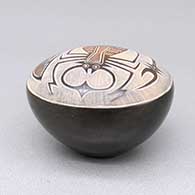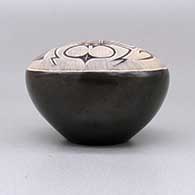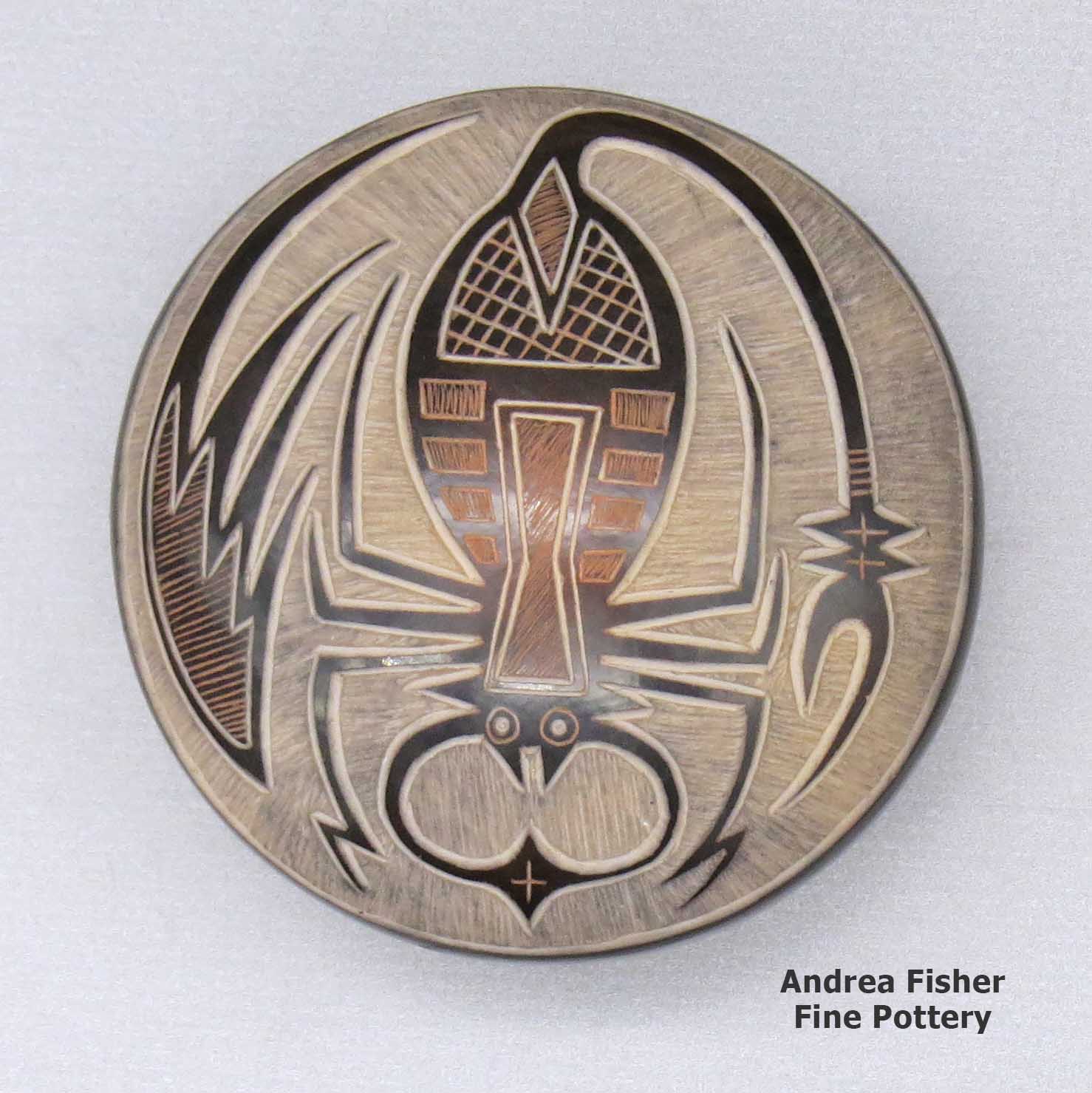
Santa Clara
$ 295
josc3k183
Black seed pot with a sienna spot and a sgraffito Mimbres scorpion and geometric design
2.5 in L by 2.5 in W by 1.75 in H
Condition: Very good, scratches on side
Signature: Haungooah JP-5-3, signed on side
Tell me more! Buy this piece!
(505) 986-1234 - www.andreafisherpottery.com - All Rights Reserved
Dean Haungooah
Santa Clara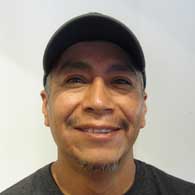
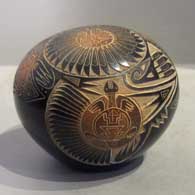
Dean Haungooah was born into Santa Clara Pueblo in February, 1972. His father was Art Haungooah (Art Cody), a Kiowa man who married Martha Suazo of Santa Clara. In the Puebloan way, they lived at Santa Clara and Dean grew up there in a family of noteworthy potters: his father and his mother, as well as Dolores Curran, Jeri Naranjo, Kevin Naranjo, Santanita Suazo and Candelaria Suazo.
Dean says he began working with clay when he was only five years old. At the age of 15 he earned the First Place ribbon for Pottery in the Juvenile Division at the Gallup Ceremonial. Later he earned a Second Place ribbon in the Adult Division at Gallup to go with it.
Dean says his favorite shape to work with is the seed pot, his favorite decorating technique is sgraffito. His designs incorporate elements from old Mimbres designs, especially Mimbres animals and insects.
Like many Santa Clara potters, he likes to smother his pots in manure as they are being fired. That turns the clay black and gives him a surface on which to apply his sgraffito designs. Then he often re-oxygenates sections of the surface to bring back that sienna color in his etched images.
Dean loves what he does as it allows him to give flight to his artistic expression without leaving home. He loves putting his hands in clay and seeing what is formed through him. Dean is also an avid bow hunter and is partial to heavy metal music. In his spare time he does youth mentoring with the teenagers in his village.
Santa Clara Pueblo

Ruins at Puye Cliffs, Santa Clara Pueblo
Santa Clara Pueblo straddles the Rio Grande about 25 miles north of Santa Fe. Of all the pueblos, Santa Clara has the largest number of potters.
The ancestral roots of the Santa Clara people have been traced to the pueblos in the Mesa Verde region in southwestern Colorado. When that area began to get dry between about 1100 and 1300, some of the people migrated to the Chama River Valley and constructed Poshuouinge (about 3 miles south of what is now Abiquiu on the edge of the mesa above the Chama River). Eventually reaching two and three stories high with up to 700 rooms on the ground floor, Poshuouinge was inhabited from about 1375 to about 1475. Drought then again forced the people to move, some of them going to the area of Puye (on the eastern slopes of the Pajarito Plateau of the Jemez Mountains) and others to Ohkay Owingeh (San Juan Pueblo, along the Rio Grande). Beginning around 1580, drought forced the residents of the Puye area to relocate closer to the Rio Grande and they founded what we now know as Santa Clara Pueblo on the west bank of the river, between San Juan and San Ildefonso Pueblos.
In 1598 Spanish colonists from nearby Yunque (the seat of Spanish government near San Juan Pueblo) brought the first missionaries to Santa Clara. That led to the first mission church being built around 1622. However, the Santa Clarans chafed under the weight of Spanish rule like the other pueblos did and were in the forefront of the Pueblo Revolt of 1680. One pueblo resident, a mixed black and Tewa man named Domingo Naranjo, was one of the rebellion's ringleaders. When Don Diego de Vargas came back to the area in 1694, he found most of the Santa Clarans on top of nearby Black Mesa (with the people of San Ildefonso). An extended siege didn't subdue them so eventually, the two sides negotiated a treaty and the people returned to their pueblo. However, successive invasions and occupations by northern Europeans took their toll on the tribe over the next 250 years. The Spanish flu pandemic in 1918 almost wiped them out.
Today, Santa Clara Pueblo is home to as many as 2,600 people and they comprise probably the largest per capita number of artists of any North American tribe (estimates of the number of potters run as high as 1-in-4 residents).
Today's pottery from Santa Clara is typically either black or red. It is usually highly polished and designs might be deeply carved or etched ("sgraffito") into the pot's surface. The water serpent, ("avanyu"), is a traditional design motif of Santa Clara pottery. Another motif comes from the legend that a bear helped the people find water during a drought. The bear paw has appeared on their pottery ever since.
One of the reasons for the distinction this pueblo has received is because of the evolving artistry the potters have brought to the craft. Not only did this pueblo produce excellent black and redware, several notable innovations helped move pottery from the realm of utilitarian vessels into the domain of art. Different styles of polychrome redware emerged in the 1920's-1930's. In the early 1960's experiments with stone inlay, incising and double firing began. Modern potters have also extended the tradition with unusual shapes, slips and designs, illustrating what one Santa Clara potter said: "At Santa Clara, being non-traditional is the tradition." (This refers strictly to artistic expression; the method of creating pottery remains traditional).
Santa Clara Pueblo is home to a number of famous pottery families: Tafoya, Baca, Gutierrez, Naranjo, Suazo, Chavarria, Garcia, Vigil, Tapia - to name a few.



Santa Clara Pueblo at Wikipedia
Pueblos of the Rio Grande, Daniel Gibson, ISBN-13:978-1-887896-26-9, Rio Nuevo Publishers, 2001
Upper photo courtesy of Einar Kvaran, Creative Commons Attribution-Share Alike 3.0 Unported License
Seed Pots
Acoma, Hopi, Isleta, Jemez, Laguna, San Felipe, San Ildefonso, San Juan, Santa Clara
Acoma Pueblo
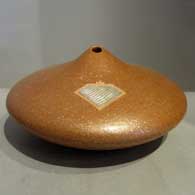
Hopi
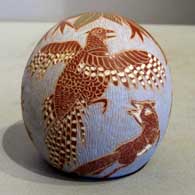
Santa Clara Pueblo
It was a matter of survival to the ancient Native American people that seeds be stored properly until the next planting season. Small, hollow pots were made to ensure that the precious seeds would be kept safe from moisture, light and rodents. After seeds were put into the pot, the small hole in the pot was plugged. The following spring the plug was removed and the seeds were shaken from the pot directly onto the planting area.
Today, seed pots are no longer necessary due to readily available seeds from commercial suppliers. However, seed pots continue to be made as beautiful, decorative works of art. The sizes and shapes of seed pots have evolved and vary greatly, depending on the vision of Clay Mother as seen through the artist. The decorations vary, too, from simple white seed pots with raised relief to multi-colored painted, raised relief and sgraffito designs, sometimes with inlaid gemstones and silver lids.
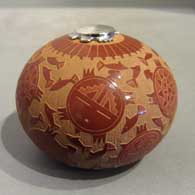
Santa Clara Pueblo
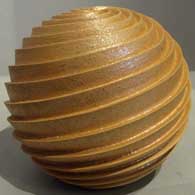
Jemez Pueblo
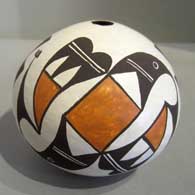
Acoma Pueblo
Santanita Suazo Family Tree
Disclaimer: This "family tree" is a best effort on our part to determine who the potters are in this family and arrange them in a generational order. The general information available is questionable so we have tried to show each of these diagrams to living members of each family to get their input and approval, too. This diagram is subject to change should we get better info.
- Shirley Duran & Joseph Duran (Tesuque)
- Aaron Duran (Tesuque, 1969-1994) & Tina Gasper (Zuni)
- Koty Duran (Tesuque, 1993-)
- Megan Duran
- Aaron Duran (Tesuque, 1969-1994) & Tina Gasper (Zuni)
- Martha Haungooah (-1981) & Art Cody aka Haungooah (Kiowa)(1943-1985)
- Dean Haungooah (1972-)
- Margie Naranjo
- Candelaria Suazo
- Mae Tapia (1952-2015) & Frank Tapia
- April Tapia & Joseph Gutierrez
- Ira Tapia & Morena Tapia
Santanita Suazo & Joe Suazo
Copyright © 1998-2024 by


